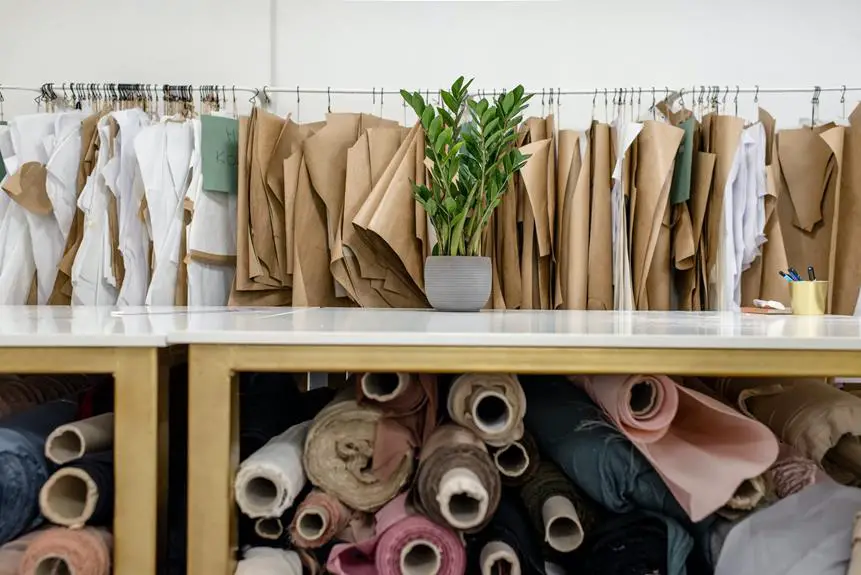When it comes to choosing between jacquard fabric and cotton, you might be wondering, 'Is the grass really greener on the other side?' Both fabrics have their own unique qualities and it's important to weigh the pros and cons of each.
From durability and texture to breathability and cost-effectiveness, understanding the differences between jacquard fabric and cotton can help you make an informed decision.
Let's dive into the characteristics of each fabric to help you determine which one may be better suited for your specific needs and preferences.
Key Takeaways
- Durability: Cotton is known for its resistance to wear and tear, while jacquard fabric is also durable and maintains its shape and color after multiple washes.
- Texture and Appearance: Jacquard fabric has a luxurious feel with intricate patterns, while cotton has a smooth surface with minimal texture and simple designs.
- Breathability and Comfort: Cotton's natural fibers allow for air circulation, making it ideal for warm weather and physical activities, while jacquard fabric, while elegant, does not offer the same level of breathability as cotton.
- Versatility and Uses: Jacquard fabric is suitable for formal and decorative purposes and is popular in high-end interior design, while cotton is versatile and well-suited for various applications, from casual clothing to everyday home textiles.
Durability
When considering durability, cotton's resistance to wear and tear and jacquard fabric's intricate weaving make a direct comparison challenging.
Cotton is known for its durability and ability to withstand frequent washing and use. Its natural fibers make it strong and less prone to pilling, tearing, or stretching, which enhances its longevity.
On the other hand, jacquard fabric, with its complex patterns woven into the fabric, also offers durability due to its tight weave. The intricate weaving technique adds strength to the fabric, making it resistant to fraying and wear.
Colorfastness is another aspect of durability to consider. Cotton, while durable, may experience some color fading over time, especially with frequent washing. On the contrary, jacquard fabric often exhibits excellent colorfastness, maintaining the vibrancy of its intricate patterns even after multiple washes.
Texture
When it comes to the texture of fabric, it's important to consider the intricate patterns of jacquard and the soft, breathable nature of cotton.
Jacquard fabric is known for its luxurious feel, while cotton is prized for its versatility.
These different textures offer unique benefits, and understanding them can help you make an informed decision when choosing between jacquard and cotton fabrics.
Jacquard Intricate Patterns
You can feel the intricate patterns of jacquard fabric when running your hand across it, creating a textured surface that distinguishes it from plain cotton. Jacquard fabric is known for its elaborate designs, which are achieved through special weaving techniques. These intricate designs are created by interlacing different colored threads to form patterns or images. Below is a comparison table highlighting the differences between jacquard fabric and plain cotton in terms of intricate patterns:
| Jacquard Fabric | Cotton | |
|---|---|---|
| Design Complexity | Elaborate and intricate patterns | Simple and basic designs |
| Texture | Textured surface due to intricate weaving | Smooth surface with minimal texture |
| Visual Appeal | Highly decorative and visually appealing | Simple and understated |
| Versatility | Suitable for formal and decorative purposes | Commonly used for everyday clothing and household items |
| Production Complexity | Requires specialized weaving techniques | Can be produced using standard weaving methods |
Cotton Soft and Breathable
Soft and breathable, cotton fabric provides a comfortable texture, making it a popular choice for everyday clothing and household items, contrasting with the textured surface of jacquard fabric discussed previously. When it comes to cotton comfort, there are several factors that contribute to its appeal:
- Breathability: Cotton's natural fibers allow for air circulation, making it ideal for warm weather and physical activities.
- Softness: The smooth and gentle feel of cotton against your skin provides a comforting sensation, making it a top choice for undergarments and bedding.
- Moisture Absorption: Cotton has the ability to absorb moisture, keeping you dry and comfortable throughout the day.
While jacquard fabric exudes elegance with its intricate patterns, cotton's softness and breathability offer a different kind of appeal, making it a preferred option for everyday comfort.
Jacquard Luxurious, Cotton Versatile
Exuding luxury with its intricate patterns, jacquard fabric contrasts with the versatile texture of cotton, offering a different kind of appeal. Jacquard fabric is renowned for its luxurious comfort, achieved through a combination of intricate weaving techniques that create elaborate designs and textures.
This luxurious fabric adds an elegant touch to any space, making it a popular choice for high-end interior design. On the other hand, cotton's versatile styling allows for a wide range of uses, from casual clothing to everyday home textiles. It offers a soft and breathable texture that's well-suited for various applications.
Whether it's the opulence of jacquard or the adaptability of cotton, both fabrics bring their own unique qualities to the table, catering to different preferences and needs.
Breathability
Regularly, cotton fabric allows air to pass through, making it more breathable than jacquard fabric. This breathability comparison is due to the open weave of cotton, which allows for better air circulation and moisture wicking properties compared to jacquard fabric. Here are the reasons why cotton is considered more breathable:
- Open Weave: Cotton fabric has a looser weave, allowing air to flow more freely through the material. This enables better ventilation and helps in keeping the body cool and comfortable.
- Moisture Wicking: Cotton has natural moisture-wicking properties, meaning it can absorb and draw moisture away from the body, allowing it to evaporate more easily. This feature contributes to the fabric's breathability, as it helps in regulating body temperature and reducing discomfort from sweat.
- Comfort in Warm Weather: Due to its breathability, cotton is often preferred in warm and humid conditions as it allows for better air circulation, keeping the body cooler and drier.
Versatility
When considering the versatility of fabrics, it's important to weigh the trade-offs between durability and comfort, as well as style and breathability.
Jacquard fabric may offer a stylish and elegant appearance, while cotton is often prized for its breathability and comfort.
Additionally, the care and maintenance of these fabrics should also be taken into account when evaluating their versatility.
Durability Vs. Comfort
You often wonder whether to prioritize durability or comfort when choosing between jacquard fabric and cotton. Both fabrics have their strengths, and the decision ultimately depends on your specific needs. Here's a breakdown to help you make an informed choice:
- Durability: Jacquard fabric is known for its durability and ability to maintain its shape and color even after multiple washes. On the other hand, cotton, while not as resilient as jacquard, is still a durable fabric, especially when woven tightly.
- Comfort: Cotton is celebrated for its breathability and softness, making it an excellent choice for everyday wear. Jacquard fabric, while also comfortable, may not offer the same level of breathability as cotton due to its intricate patterns and denser weave.
- Longevity: If you prioritize longevity and resilience, especially for upholstery or heavy-use items, jacquard fabric might be the better choice. However, for everyday clothing and bedding where breathability and softness are paramount, cotton could be the preferred option.
Stylish Vs. Breathable
For those seeking a fabric that is both stylish and breathable, the choice between jacquard and cotton can depend on the specific versatility needed for different uses. Both fabrics offer unique benefits when it comes to style and breathability. Jacquard fabric is known for its intricate patterns and luxurious appearance, making it a popular choice for stylish garments and home decor. On the other hand, cotton is celebrated for its exceptional breathability and comfort, making it ideal for everyday clothing and bedding. Here's a comparison to help you understand the versatility of these fabrics:
| Stylish | Comfort | Breathability | Durability | |
|---|---|---|---|---|
| Jacquard | ✔️ | ✔️ | ||
| Cotton | ✔️ | ✔️ | ✔️ |
Understanding the specific needs for stylishness and breathability will help you make the best choice between jacquard and cotton for your various uses.
Care and Maintenance
To ensure the versatility of both jacquard fabric and cotton, it's important to consider their care and maintenance requirements, as this will impact their longevity and usability.
When it comes to caring for jacquard fabric and cotton, here are some essential tips to keep in mind:
- Gentle Washing: Both jacquard fabric and cotton benefit from gentle washing. Use a mild detergent, cold water, and a gentle cycle to help preserve the fabric's integrity and color vibrancy.
- Avoid Harsh Drying: When drying jacquard fabric and cotton, opt for air drying or a low heat setting in the dryer to prevent shrinkage and maintain the fabric's structural integrity.
- Steam Ironing: To remove wrinkles and creases, steam ironing is ideal for both jacquard fabric and cotton. Ensure the iron's heat setting matches the fabric's needs to prevent damage.
Maintenance
Regular maintenance of jacquard fabric requires more attention and care than that of cotton, due to its intricate weave and delicate nature. When it comes to washing jacquard fabric, it's essential to follow the specific washing instructions provided by the manufacturer.
Typically, it's recommended to hand wash jacquard fabric in cold water using a gentle detergent. Avoid using bleach or fabric softeners as they can damage the fibers and intricate patterns. After washing, gently squeeze out excess water without wringing and lay the fabric flat to dry to maintain its shape and prevent distortion.
In contrast, cotton fabric is more forgiving and can usually be machine washed and dried without much concern. However, it's important to separate light and dark colors to prevent color bleeding. Additionally, cotton can withstand higher temperatures, so hot water and a regular laundry detergent are suitable for cleaning.
Appearance
When comparing jacquard fabric and cotton, you'll notice that the intricate patterns and lustrous sheen of jacquard fabric give it a more luxurious appearance than cotton. Here are some key points to consider regarding the appearance of these fabrics:
- Intricate Patterns: Jacquard fabric is renowned for its intricate patterns that are woven directly into the fabric. These patterns often include floral motifs, intricate geometric designs, or other detailed patterns that add a sense of elegance and sophistication to the fabric.
- Lustrous Sheen: Jacquard fabric has a subtle sheen that adds to its opulent appearance. This sheen is a result of the way the fabric is woven, creating a beautiful play of light and shadow that enhances the overall look of the fabric.
- Colorfastness: Jacquard fabric is known for its excellent colorfastness, meaning that the rich and vibrant colors of the fabric are likely to remain intact even after multiple washes. This attribute contributes to the long-lasting beauty and appeal of jacquard fabric.
Cost-effectiveness
Considering the long-term durability and maintenance costs, choosing between jacquard fabric and cotton can be a significant decision.
Jacquard fabric is often viewed as a long-term investment due to its durability and ability to maintain its appearance over time. While cotton may have a lower initial cost, it may require more frequent replacements due to wear and tear, making it potentially less cost-effective in the long run.
When evaluating cost-effectiveness, it's essential to consider the fabric's longevity and the initial cost. Jacquard fabric, known for its intricate woven patterns and durability, offers a budget-friendly option in the long term. Its ability to withstand daily use and maintain its appearance can result in fewer replacements and lower maintenance costs, making it a cost-effective choice for those looking for a durable and long-lasting fabric.
On the other hand, while cotton may be initially cheaper, its long-term maintenance and replacement costs could potentially make it a less budget-friendly option in the grand scheme of things. Therefore, when considering cost-effectiveness, it's crucial to weigh both the initial cost and the long-term durability of the fabric.
Environmental Impact
To assess the environmental impact, you should compare the sustainability of jacquard fabric and cotton over their lifecycle. Both jacquard fabric and cotton have environmental implications throughout their production processes. Here's a comparison of their environmental impact:
- Textile Production: Jacquard fabric is often made from synthetic fibers such as polyester, which are derived from non-renewable resources and require a significant amount of energy to produce. On the other hand, cotton production involves the use of pesticides and fertilizers, which can have negative impacts on soil and water quality.
- Water Usage: Jacquard fabric production typically requires less water than cotton, as cotton is a particularly water-intensive crop. The cultivation of cotton consumes vast amounts of water, leading to potential water scarcity issues in some regions.
- Sustainability: While cotton is a natural and biodegradable material, its production has a higher environmental impact due to factors such as pesticide use and water consumption. Jacquard fabric, although made from synthetic fibers, can be recycled, reducing its environmental impact in the long run.
Considering these factors, both jacquard fabric and cotton have environmental implications, and the choice between them should be made based on a comprehensive understanding of their respective environmental footprints.
Frequently Asked Questions
How Does the Production Process of Jacquard Fabric Compare to Cotton in Terms of Environmental Impact?
When considering the environmental impact of the production process, it's important to note that jacquard fabric and cotton differ. Jacquard, with its intricate weaving method, may require more resources and energy compared to cotton's simpler production.
Can Jacquard Fabric Be Easily Dyed or Printed On, Like Cotton?
Yes, jacquard fabric can be easily dyed or printed on, similar to cotton. When comparing to cotton, jacquard printing and dyeing processes showcase its versatility. Both fabrics offer excellent potential for various design applications.
Are There Any Special Maintenance Requirements for Jacquard Fabric Compared to Cotton?
To maintain jacquard fabric, follow specific care instructions such as gentle washing and avoiding direct sunlight to preserve its durability and unique designs. While cotton offers more color options and ease of care, jacquard's maintenance requirements ensure its longevity.
Does Jacquard Fabric Have Any Unique Benefits or Drawbacks in Terms of Versatility That Cotton Does Not?
Jacquard fabric offers unique patterns and texture, making it versatile for various applications. Its durability and intricate designs set it apart from cotton, providing a distinctive option for those seeking a refined and long-lasting textile.
What Are the Typical Cost Differences Between Jacquard Fabric and Cotton?
Typical cost differences between jacquard fabric and cotton vary based on factors like material durability. The cost of jacquard fabric may be higher due to its intricate patterns, while cotton is generally more affordable.
- Tetron Fabric for Marine Applications: Durability and Use Cases - June 18, 2025
- Tetron Fabric for Outdoor Furniture: Weather Resistance and Care - June 18, 2025
- Tetron Fabric for Wall Coverings: Style and Application Tips - June 18, 2025





